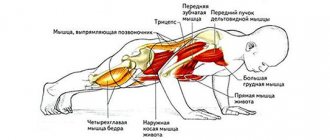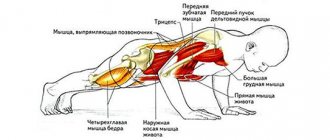An effective push-up program for beginners helps to pump up the pectoral muscles and make the torso sculpted in just 6 weeks. However, such results can be achieved through hard training. In accordance with the training program for men, you will eventually need to reach 100 push-ups, which is not always a feasible task for beginner athletes. But if you have a great desire, your plan will definitely come true. A huge advantage of such activities is that they can be done at home.
On a note! Push-ups are an exercise that can be done anywhere. If you adhere to the correct technique, you will be able to pump up your pectoral muscles quite quickly.
Floor push-up program. Intermediate level integrated circuit.
The floor push-up program is a special complex in which push-ups are performed according to a special load schedule.
As a result, a person who has trained according to this schedule increases his record in push-ups. I present one of these programs, which has proven itself well in training fighters. It's called a push-up integrated circuit. Use this program if you can do at least 30-40 push-ups. If your record is still lower, use simpler schemes.
For training, you will need a stopwatch, since this push-up scheme is based on time manipulation, which is much more effective than a straight-line increase in the number of push-ups proposed in numerous schemes from the Internet.
The essence of the integral push-up program
Let's say you can now do 50 push-ups per set and want to do 70 push-ups. Divide this planned number of push-ups (70 times) into 5-7 approaches. You will get sets of 14-10 repetitions. My push up routine is given below. assumes that the future record is divided into five approaches. That is, there will be 14 repetitions in each approach. The initial rest time between sets is 1 minute.
Every week we will reduce the rest time between sets of push-ups by 10-15 seconds. To be more realistic, it is better to reduce pauses by 5-10 seconds per week. As practice shows, for half of trainees, too fast a pace of reducing pauses between approaches leads to difficulties already in the third week of classes.
Thus, after a few weeks, the rest period between sets will be reduced to zero seconds, and you will do 70 push-ups in one set. That is, all five approaches will become one approach - your new record.
The push-up program should be done 3-4 times a week. Best every other day.
Attention: it is important to perform push-ups as quickly and powerfully as possible, but with very precise technique. Do not reduce the range of motion or distort the trajectory. Perform push-ups quickly but accurately, breathe correctly.
Source
Push-up home training program (mistakes)
I will tell you about the mistakes that prevent the growth of the pectoral muscles.
Everyone knows that push-ups are one of the most basic exercises; progress can be endless. The first mistake is the amplitude of movement
. Steadily, you should go as low as possible (touch your chest to the floor) and tense your pecs as you rise. Feel your pectoral muscle group.
The second mistake is your pace.
If you are training for endurance, then push-ups should be done at a fast pace, but if you are working on building chest shape, such push-ups are not permissible. The approximate tempo when working is 6 seconds down and 3 seconds up. When you change the pace and amplitude of the movement, you will immediately feel how your pectoral muscles are worked.
Third error: no progress.
Make your push-ups harder.
Raise your level. Along the way, we’ll look at the training program.
How to increase the number of push-ups
Push-ups are an exercise that helps strengthen and develop the muscles of the upper shoulder girdle.
Due to its versatility, it is one of the main standards for determining the level of physical fitness.
In this article, we will detail how to increase the number of push-ups you can do to improve your progress.
Daily push-ups - what effect do they give, benefit or harm?
- Doing push-ups every day does not lead to the development of strength and muscle mass gain. The body simply does not have time to recover a day after the previous load. And, let's be honest, the load is not so great if you can easily repeat the workout the next day.
- But as exercise, to maintain muscle tone and prevent various diseases, push-ups every day will come in handy.
httpv://www.youtube.com/watch?v=embed/oW9GfQuhSVE
- If you do push-ups every day or every other day, your arms and chest are much stronger and more resilient than the average person.
- If you do at least 20 push-ups, there is a chance that you will be able to push away an opponent or a heavy object that has fallen on you in an unexpected situation.
- Push-ups are necessary to train breathing and increase blood circulation. And the latter is required for good health and the prevention of many diseases.
- Any workout is a reminder to muscles and joints of their functions. They even say about cars that it is “harmful” for them to stand in the garage for a long time.
To determine the number, do as many push-ups as you can in the morning. Take 60-80% of this number, round up and do push-ups this number of times as exercise. This way you will know how many push-ups you need to do per day.
httpv://www.youtube.com/watch?v=embed/a0KxqXdlsZs
- There is a risk of overwork and losing more weight than normal due to muscle wasting.
- You will constantly feel tired hands, which is not very pleasant. The muscles will not have time to recover.
- Your elbows may start to hurt. The joint resource is also not infinite.
- Elbows pressed to the body - 5-10 times. Here the main load goes to the triceps.
- Elbows to the sides, palms inward - the same amount. Breasts work.
- 5-10 times in the position indicated in diagram 1. Uniform load.
- 5-10 times on fists. Fists are needed to increase the range of motion. This will engage the pectoral muscles more.
httpv://www.youtube.com/watch?v=embed/WQpIGna2W10
How to do more push-ups
If you can do at least 10-12 push-ups, feel free to skip this section and go straight to the training program.
Well, if regular push-ups are still difficult, this information is for you.
Instead of the floor version, use a simplified version - from the crossbar or from the knees.
Regularity of training – 3 training sessions per week.
Week 1
Day 1 – 2 sets of 10 reps
Day 2 – 3 sets of 10 reps
Day 3 – 4 sets of 10 reps
Week 2
Day 1 – 3 sets of 12 reps
Day 2 – 2 sets of 15 reps
Day 3 – 1 set of 17 reps
Week 3
Day 1 – 3 sets of 15 reps
Day 2 – 2 sets of 18 reps
Day 3 – 3 sets of 16 reps
Week 4
Day 1 – 2 sets of 20 reps
Day 3 – 1 set of max reps
As soon as you manage to do 25-30 push-ups from your knees, move on to classic push-ups.
On average, you will be able to do this 8-10 times.
Now you can move to the next level and train according to the program to increase the number of push-ups.
Dips at home training program
In my opinion, the main basic exercise for the chest is, of course, the bench press, and the second most important exercise is the parallel bars. If you want big breasts, you should definitely do dips. The at-home dips training program is effective not only in the gym, but also if you train on the sports field. If you want to become big, be sure to increase the weight of the weight. Without parallel bars, it is not possible to fully progress in increasing the pectoral muscles.
Dips at home training program for beginners
Set of 9 approaches. The main thing is to work not only with your own weight, but also be sure to use weights like backpacks, chains, and weights.
- approach (warm-up) 8-16 repetitions with your own weight.
- set 6-15 with maximum weights
- set 6-15 with maximum weights
- set 6-15 with maximum weights
- approach 6-15 average weight
- approach 6-15 average weight
- approach 6-15 average weight
- maximum bodyweight approach
- bodyweight approach to the max.
The break between sets is 2 minutes. By technique. Lean forward a little, look at the floor, elbows to the side so that your chest works well. Body back. Get down as low as possible and stretch your chest. At the top we take a short pause to contract the chest muscles. Raise your knees slightly. Don't skip the negative phase, do everything slowly. Don't swing.
Push-up program
There are still three training sessions a week.
This frequency of loading is optimal for rapid progress.
You should not copy the training schemes of professionals who train every day. Most often, the use of pharmacology and a high level of training help them recover.
At the first training session of the cycle, set a personal record - do one approach for the maximum number of repetitions until failure.
This figure will be the starting point in calculating the load.
For example, you managed to do 12 push-ups. This is your maximum.
Next we work according to the formula:
4×(max−4). That is, 4 sets of 8 repetitions.
Week 1
Workout 1 – 4 sets of (max−4) reps
Workout 2 – 3 sets of (max−3) reps
Workout 3 – 2 sets of (max−2) reps
Week 2
Workout 1 – 4 sets of (max−3) reps
Workout 2 – 3 sets of (max−2) reps
Workout 3 – 2 sets of (max−1) reps
Week 3
Workout 1 – 2 sets of (max−2) reps
Workout 2 – rest
Workout 3 – new maximum record!
At the end of the three-week cycle, you will set a new personal best in push-ups.
If you want to progress further, then the new program will be built according to the same scheme, starting from the new maximum in push-ups.
How long to rest between sets
Push-ups are considered a basic multi-joint exercise.
If you work in a strength style and your limit is 15-20 repetitions, rest between sets should be 2-3 minutes.
If you can do more than 20 repetitions per set and have a goal to increase the number of push-ups even more, then you are working on developing strength endurance.
The body recovers faster after such loads, so pauses between approaches can be reduced to 1-2 minutes.
Doing the exercise in the morning
Push-ups are often practiced as an element or main exercise for morning exercise. However, morning exercises can cause certain harm to the body:
- load frequency. Intense push-ups (several approaches, a large number of repetitions, the presence of weights, etc.) are best performed with a break of 24 hours. Otherwise, a state of overtraining will quickly arise. A few simple push-ups can be practiced daily;
- warm-up Before morning push-ups, warming up is important, otherwise unwarmed muscles and joints will be more likely to be injured.
Common Mistakes
Errors when doing push-ups can be divided into two groups - technical and methodological.
The most common technical errors include:
Either lowering the pelvis in the direction of movement (the most common), or excessively lifting it up.
Thus, the lumbar region is overstrained, and the abdominal muscles do not receive their indirect load.
Too wide a stance reduces the range of motion and makes the exercise easier to perform, while increasing the load on the shoulder joints.
This also includes the position of the palms, placed strongly forward, beyond the line of the shoulders.
Increases intra-abdominal and blood pressure in general. And this negatively affects productivity and well-being.
More information about the correct technique can be found here.
The most common methodological errors include:
Without quality restoration, progress is impossible.
Home workout program for dips (mistakes)
- error, skipping a negative phase. Using inertia you destroy the negative phase, and this is half the exercise.
- error, body deviation back. Not any rocking.
- mistake, very strong forward lean.
To summarize, the push-up home training program is an effective training program. The main thing is the execution technique. Push-ups are a strong compound exercise that you can use to improve your body. Play sports at home and in the gym, take care of your health and adhere to a healthy lifestyle.
The whole truth about how much rest you need between sets
As I said above, the information about how much rest you need is very mixed, and it was based on rumors, guesses and unclear advice, unverified information. I could also say that everyone needs to rest for 1-2 minutes to sow corn and end the article there, but that would be the height of indecency towards you. Therefore, we will not rely on various heresies, but will simply connect the latest scientific research to this question and find out what numerical answer these bright minds offer us.
How long should you rest between sets: research
No. 1 Duration of rest. Hypertrophy
No. 2. Duration of rest. Strength and Power
When a person trains with weights, they (mostly) use two systems. The first of them is creatine phosphate, the action of which lasts from 0 to 10 seconds of the entire work and the second is the glycolytic system, which is designed for a period of 30-90 seconds, and in which we use muscle glycogen (or the stored form of carbohydrates) as a source of work .
Creatine phosphate is the most powerful system for supporting muscle work, and it takes 3 to 5 minutes to replenish its reserves (after a heavy set). For strength and power work, each set should proceed with the maximum possible number of repetitions (while maintaining technique) of the heavy weight lifted. Research shows that for this to happen, the body needs 3-5 minutes of rest. This will result in sufficiently reduced lactic acid levels and higher creatine phosphate stores for each set.
Summarizing all of the above, we can draw the following conclusions - you need to rest between approaches:
That's all here, let's move on.
Basically there are three:
Based on these three factors, let's try to figure out how to derive specific rest numbers between approaches and exercises. In most sources of information you can come across such time frames from 30 seconds to 5 minutes. What can I say, quite a wide range, let's try to narrow it down by applying each factor in a specific situation.
How Intensity and Rep Range Affect Rest Time
So, for example, if you do 6 reps per set, then you should rest more between sets than if you did 12 reps per set of the same exercise.
How exercise itself affects rest time
Along with the number of repetitions in a set, the exercises performed also influence the time of non-canting. Everything is very simple here:
If we look at muscle groups, here's how to distribute rest time.
How does your main goal affect your rest time?
Rest time between sets can be classified in 2 different ways, full and partial. Both of them have their pros and cons, depending on your goal.
For those who still don’t know how to set fitness/bodybuilding goals correctly, the following article [Where to start working out in the gym?] will come in handy.
Full rest time
This type of rest is longer in duration and promotes better recovery of the central nervous system. This means you'll be able to maintain your performance capacity longer, improve your maximum strength output, be prepared for heavy, high-rep sets, and lift heavier weights for higher reps.
Fatigue and metabolite accumulation (which play an important role in fat loss, muscle building, and improved muscle endurance) are generally lower.
Partial rest time
I'm sure many of you have a question on your lips...
What type of holiday is best for me?
And here it all depends on the goal. Full or partial rest time may be suitable for you, or perhaps a combination of one or another type. Here's what I mean:
So now it's time to answer the most important question...
How long should you rest between sets?
Putting all three factors together (and taking into account your goal), the following picture emerges:
So, it seems that we have sorted this out, all that remains is to answer the question...
How long should you rest between exercises?
In the training process, everything is interconnected, i.e. rest between exercises usually depends on how long you rested between sets of the previous exercise. This means that if you rested 3 minutes between sets of exercise #1, then you should rest about 3 minutes before performing the first set of exercise #2.
Conclusion: when answering the question of how much rest you need between sets, you need to be more strict and consistent in observing the norms of rest between sets and not be too scrupulous about the rest time between exercises.
Well, in fact, all temporary issues have been considered.
To somehow summarize all this chatter, I will give general recommendations regarding setting the rest time for yourself. I would formulate them like this:
Now that’s it, all that’s left is to wave to each other and say goodbye.
Afterword
How long should you rest between sets? This is the question we tried to answer today. I am sure that now you have formed a clear picture regarding “relaxation” during training, and you will no longer have to return to this issue.
That's it, in that spirit, that way, until we meet again, my dears!
PS. I passed by the comments and didn’t unsubscribe - I delayed the new article!
P.P.S. Did the project help? Then leave a link to it in your social network status - plus 100 points to your karma, guaranteed.
With respect and gratitude, Dmitry Protasov.
Source
Push-up home workout program
A home workout program, push-ups, is an effective way to get in shape.
Using a wide variety of push-up methods, you can create a training process that serves any purpose. Let's look at the training plan in more detail: workout program at home, push-ups for fat burning. A high-intensity push-up home workout program will consist of 6 exercises. We will perform each exercise for a minute, the exercises sequentially one after the other, with 45 seconds of rest between them. Three circles of such exercises, 2 minutes of rest between circles.
Warm-up
Like any workout, a push-up training program at home begins with a warm-up.
Stretch your cervical spine and lower back well (circular movements, bends, turns). Do a little stretching, stretch your muscles and ligaments. Stretch your knee and ankle joints. Warm-up is a very important part as we must prepare our body well for the upcoming loads. Give directions to our central nervous system, and prepare our brain for active activity.
Main part
1. Exercise: classic push-ups
Place your arms slightly wider than your shoulders, straight back, lower your chest and touch the floor, rise and fully straighten your arms at the elbow joints. We perform the exercise for one minute. Rest for 45 seconds and move on to the next exercise.
2. Exercise: squats
Let's include legs and buttocks in our workout. Starting position: feet shoulder-width apart, arms in front of you. We perform a squat just below parallel to the floor, the back is straight, the toe does not go beyond the knee. We rise and fully straighten the knee joint. We perform the exercise for a minute, rest for 45 seconds and move on to the next exercise.
3. Exercise: close grip push-ups
Narrow stance of the arms, the elbow joint runs along the body. The triceps are included in the work. We try to lower our body as low as possible and touch the floor. When lifting, fully straighten your arms at the elbow joint. We work for a minute, rest for 45 seconds.
4. Exercise: Jumping from a low squat
Starting position: feet shoulder-width apart, hands behind your head. We lower ourselves into a squat and perform a jump. Watch your back position. The back is straight, we follow the breathing.
5. Exercise: opposite push-ups
This option makes each arm work more intensely and works the shoulder joint well. The starting position of the arms is slightly wider than the shoulders, lower the body to the left hand, and return to the starting position. Next, we lower the body to the right hand and return to the starting position. We perform the exercise for a minute, rest for 45 seconds and move on to the next final exercise.
6. Exercise: Burpee
Classic exercise. Watch your breathing and perform the exercise efficiently. Effective exercise involves all the muscles in our body. The starting position of the legs is shoulder width apart. Next, we move to the squat position, perform a prone position, do push-ups, and through the squat return to the starting position. From a squat position we perform a jump.
We rest for two minutes, restore our breathing, and move on to the second round of our circuit training.
100 push-ups program
An effective training program that can strengthen the pectoral muscles and create an athletic torso in 6 weeks, increasing the number of push-ups to 100 times.
The main rules when performing push-ups will be the following points:
1) To pump up the pectoral muscles well, make sure that when lowering your torso, your elbows move to the sides; if you press them to your torso, the load will move to the triceps and the chest will not receive proper training.
2) Don’t try to trick yourself, you need to go down quite low, there should be at least 10 cm from your chest to the floor. If you served in the army, you know that a fist should be placed between the floor and the chest.
3) The torso from shoulders to heels should be level, do not stick your butt up and do not bend your lower back, this way, of course, you will make push-ups easier for yourself, but also reduce the usefulness and effectiveness of the exercise.
4) Don’t forget to breathe correctly, so that your breathing doesn’t get lost and shortness of breath doesn’t appear in the middle of the exercise, you need to inhale while relaxing when lowering, exhale while trying to rise, try to inhale through your nose and exhale through your mouth. This is especially important outside and in the cold season, so that the air enters the lungs clean of dust and already warm.
5) If at the end of the program you have completed 100 push-ups, make life more difficult for yourself and further increase your stamina and chest development by wearing a backpack with bottles of water or a bag of sand.
Is harm possible and how to avoid it
Actively engaging in push-ups and neglecting other exercises will lead to your chest becoming too inflated, and therefore very wide. This spoils the appearance.
If you don’t know how to wisely distribute the load on your body, you will get tired quickly. This often happens to beginner athletes who want to give their best and do not think about the consequences. Moderation is the most important thing.
There is a high chance of injury if you neglect to warm up.
Push-ups are not recommended:
- men with high blood pressure;
- men who had injuries to the spine, arms and other skeletal problems;
- men with fragile bones.
Frequently asked questions
I couldn’t complete the entire number of repetitions, what should I do?
How long to rest between sets of push-ups?
Usually the time for rest is 60 seconds, but if you yourself feel that this time is not enough, there is nothing wrong with a longer rest of 2-4 minutes. You shouldn’t rest any longer, as the muscles will lose their warmth and go out of “combat readiness” state.
How many times a week do you train?
The 100 push-ups program has been successfully completed, what next?
So, the push-up pattern itself looks like this:
If you have completed all 6 weeks, then you are ready to achieve your main goal, rest for 1-2 days and do 100 push-ups in 1 set.
Train, may your health be strong and your muscles toned, good luck!
Source










